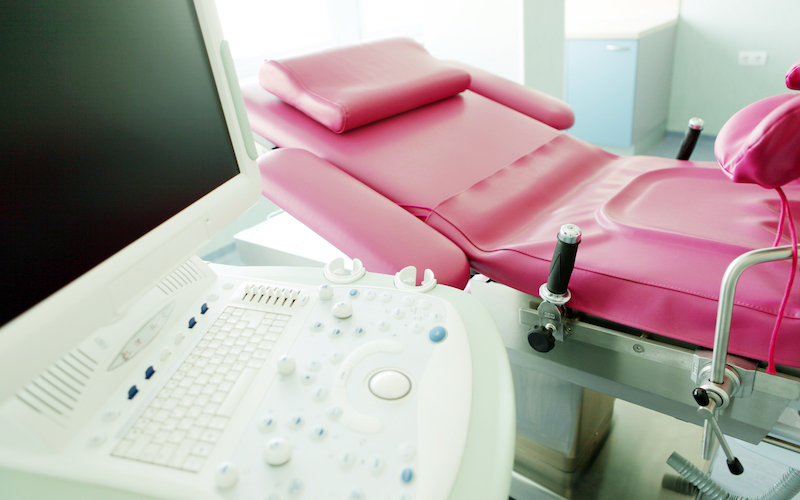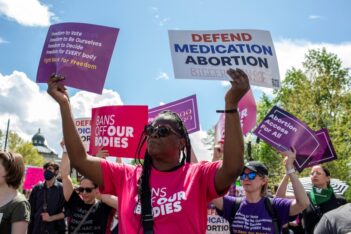
A concurring opinion leaves the standard for determining the constitutionality of abortion restrictions in doubt.
At the end of June, the U.S. Supreme Court handed down its decision in June Medical Services v. Russo. At issue was a Louisiana law, the Unsafe Abortion Protection Act. Like hundreds of similar state laws across the country, this law would have made abortion services difficult, if not impossible, to obtain in Louisiana.
A majority of the Court struck down the Louisiana law, but five justices did not agree on why the law was unconstitutional. Chief Justice John Roberts concurred only in judgment—and his concurrence may be the key to understanding what regulations the Court will or will not permit in the future.
The Louisiana Act was almost an exact replica of a Texas law that the Court struck down four years earlier in Whole Woman’s Health v. Hellerstedt. Both laws required abortion providers to obtain admitting privileges at a hospital no farther than 30 miles away from their office—privileges that hospitals can deny for subjective reasons unrelated to the quality of care. If the statute had taken effect in Louisiana, probably only one physician in the entire state could have acquired admitting privileges and qualified to provide abortion services.
Justice Stephen Breyer, who wrote the majority opinion in Whole Woman’s Health, announced the Court’s judgment in June Medical Services. The plurality, which also included Justices Ruth Bader Ginsburg, Sonia Sotomayor, and Elena Kagan, determined that the law created an unconstitutional “undue burden” on access to abortion services, failing to satisfy the standard established in Planned Parenthood v. Casey. Chief Justice Roberts, who cast the pivotal fifth vote to invalidate the law, emphasized the value of upholding precedent but noted that he had disagreed with the outcome in Whole Women’s Health when it was decided.
Chief Justice Roberts’s concurrence, while extolling the importance of stare decisis, narrowed the scope of the undue burden test. The central difference between Chief Justice Roberts’s and Justice Breyer’s opinions is whether the law’s health benefits, if any, are relevant to deciding whether an abortion restriction is constitutional.
In Whole Woman’s Health, Justice Breyer weighed the benefits conferred by the Texas statute against the burdens it placed on abortion access. Likewise, in June Medical Services, Justice Breyer concluded that the Louisiana law offered no benefit for patient safety or health. Hospital admitting privileges, which the district court found each provider had pursued in good faith, do not necessarily establish a provider’s competency or their credentials to practice medicine.
At the same time, the Louisiana Act would have resulted in increased crowding and longer waiting times. Had the statute taken effect, all but one or two clinics would have closed, and the state’s sole provider could not have met the demand of the 10,000 Louisiana residents seeking abortions each year. Moreover, some patients may have been forced to travel hundreds of miles to reach a clinic. And because Louisiana also mandates that patients have an ultrasound and a counseling session 24 hours before an abortion, some patients would need to take two trips or find overnight accommodation to exercise their right to have an abortion.
Chief Justice Roberts agreed with the plurality that the burdens the law imposed were substantial obstacles to the provision of abortion services. Even though he dissented in Whole Woman’s Health, his concurrence took note of the distances patients would have to travel to reach the state’s remaining provider, along with the difficulties that come with travel, such as securing transportation or child care. For Chief Justice Roberts, however, a balancing assessment of the benefits for patients’ health and the burdens to abortion access does not determine a law’s constitutionality. Consequently, one reading of the Chief Justice’s opinion is that a state could enact an abortion restriction with no actual health benefits and such a restriction would be constitutional so long as it does not impose a “substantial” burden on people’s ability to gain access to abortion.
After June Medical Services, what constitutes a substantial burden? More specifically, what proof would convince the Chief Justice—now the apparent swing vote on abortion issues—that a law creates substantial obstacles? The answer will depend on evidence of a law’s effects on abortion access, which varies from place to place and based on the type of restriction.
Litigants will confront these questions in cases currently before the U.S. Court of Appeals for the Seventh Circuit. The same week that the Supreme Court handed down June Medical Services, it asked the Seventh Circuit to reconsider two recent decisions concerning two different Indiana abortion restrictions.
The first law required parental notice of minors’ abortion decisions—even if the minor had received a judicial order circumventing parental involvement—unless such notice was contrary to the minor’s best interests. The second required that patients in Indiana wait 18 hours between having a state-mandated ultrasound and an abortion procedure. The Seventh Circuit held that both laws created unconstitutional undue burdens on the right to abortion.
The outcome of the ultrasound case, Planned Parenthood of Indiana and Kentucky v. Indiana State Department of Health, may provide a roadmap for how June Medical Services will apply to the judicial review of other abortion restrictions. The Seventh Circuit originally held that the undue burden test set forth in Whole Women’s Health was consistent with the standard announced in Casey. These two cases, according to the Seventh Circuit, demand a “context specific” analysis of a law’s effects and purposes based on “the evidence in the record—including expert evidence.”
Chief Justice Roberts’s June Medical Services concurrence, however, rejected the argument that Casey and Whole Woman’s Health applied the same standard. On remand, the Seventh Circuit could adopt the Chief Justice’s interpretation of Casey and Whole Women’s Health, which emphasizes a law’s burdens, not its benefits. Alternatively, the Seventh Circuit could find, as a federal district court in Maryland did recently, that lower courts are not bound to apply the Chief Justice’s concurrence.
The Seventh Circuit also could alter its analysis of the benefits of the 18-hour waiting period to reflect Chief Justice Roberts’s concurrence. Before the Supreme Court remanded this case, the Seventh Circuit had held that Indiana produced no credible evidence showing that the waiting period was medically necessary or created opportunities for patients’ meaningful reflection. Moreover, Indiana offered only one study claiming that abortion correlated with “moderate to highly increased psychological problems”—a study that the Seventh Circuit determined was “controversial and much maligned.”
But if courts adopt the approach of Chief Justice Roberts’s concurrence, the benefits a state purports to accomplish need not be proved. For example, to uphold the ultrasound law, it matters only that Indiana has stated an interest in providing patients information and time for reflection, even if not one patient learns more about their pregnancy or changes their mind.
In light of June Medical Services, the Seventh Circuit’s analysis of how the ultrasound requirement erects obstacles to abortion access is all the more important. In June Medical Services, five members of the Court—including Chief Justice Roberts—considered the negative health consequences of inaccessible abortion, rather than deferring to the Louisiana legislature’s proffered rationale of protecting pregnant people’s health.
The Seventh Circuit, in the same way, described the costs to patients who would have to make two trips to one of the four clinics across the state that perform ultrasounds and abortions. Without the 18-hour requirement, patients can visit one of 17 nearby clinics for their mandatory informed consent sessions, and then travel to a provider for the ultrasound and abortion on the same day. With the 18-hour requirement, two trips to an abortion provider might require a more than two-hundred mile drive for some patients. The Seventh Circuit held that the ultrasound waiting period would result in “additional travel expenses, child-care costs, loss of entire days’ wages, risk of losing jobs, and potential danger from an abusive partner”—all of which are significant burdens on those seeking abortion.
The Seventh Circuit specifically recounted expert testimony, explaining “the impact of the new law on these interconnected stressors and on the already precarious financial lives of poor women seeking an abortion.” Notably, the Seventh Circuit provided a breakdown of the incomes of abortion patients in Indiana—56 percent had incomes below 200 percent of the federal poverty line—and a detailed examination of how the costs of compliance with the law would strain household budgets.
The Seventh Circuit, like the Supreme Court in June Medical Services, had the aid of a well-developed record. The record before the Seventh Circuit contains persuasive evidence of the harm that restrictions would cause, measured by peer-reviewed research and supported by the testimony of experts.
Similarly, in June Medical Services, the plurality concluded that the Louisiana law undermined patients’ health rather than advanced it, relying on reports and depositions that emphasized the financial, social, and practical effects of delayed or denied abortion care. Resembling the reasoning of the Seventh Circuit, both the plurality and the concurrence in June Medical Services highlighted the reduced availability of abortion services, the increased distances between patients and providers, and transportation and childcare obligations. These practical hurdles would increase delays, and consequently, increase health risks for patients. Importantly, Chief Justice Roberts’s concurrence does not contradict the Seventh Circuit’s observation that a law’s burdens can be cumulative and contextual—delays and costs compound for abortion patients who already struggle to make ends meet.
Following June Medical Services, some abortion regulations will fall after evidence confirms that a restriction puts abortion services too far out of reach—a matter of degree and a contest of evidence. Some anti-abortion statutes, particularly laws that lower courts conclude impose minimal burdens, will stand. Laws that do not shut clinic doors or excessively increase travel distances for patients, for example, may be closer calls given Chief Justice Roberts’s concurrence.
Consider so-called fetal discrimination statutes, which ban abortions that are motivated by the fetus’s sex, race, or genetic anomaly. Although a court permanently enjoined Indiana’s ban, laws that attempt to restrict the reason for abortion are increasingly popular. Reason-based bans do not drive providers out of business, but they can deter people from seeking services or chill the care offered by providers—in the name of respecting potential life, not protecting patient health.
Targeted restrictions on abortion providers rarely accomplish their stated goals; rather, they serve to test the scope of the U.S. Constitution’s prohibition on abortion restrictions. How much do the effects and stated purposes of a law matter? June Medical Services does not offer a clear answer.
This essay is part of a series entitled The Supreme Court’s 2019-2020 Regulatory Term.




